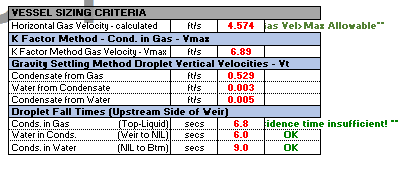Dear members,
Greetings
I am a junior engineer, doing a separator sizing check for the separators that our Client has. I need to determine the maximum capacity of the separator can accomodate in case our Client want to maximize their production in the future.
I am still new to this separator sizing so, I would like to ask for your assistance. It is a horizontal 3 phase separator completed with demister.
All I know is that basically there are 2 methods to size a separator; K factor method and settling velocity using droplet size.
I tried to calculate it using inhouse spreadsheet but the result appear to be garbage. Before I start determine the maximum capacity, initially I put the flowrate, vessel data including dimension, weir, level setting, and everything. I also had already specify the criteria based on Client's criteria and GPSA/API 12J.
But it gave me error result, saying that the settling velocity isn't sufficient enough, that is very far from the criteria given. It doesn't make sense since our Client's current operation is running on that data. I believe there is something wrong with the calculation but I have no idea of what/where.
I really appreciate if you can enlighten me, review and correct my spreadsheet calculation attached.
Here are the input data:
gas: 123037.78 lb/h (59.88 MMscfd)
condensate: 965.32 lb/h
water: 145.7 lb/h
dimension 2200 x 6000 mm, weir height 1150 mm
Level setting for both side:
HHLL: 1100 mm
HLL: 800 mm
NLL: 650 mm
LLL: 500 mm
LLLL: 200 mm
retention time: 3-5 minutes
droplet size: 90-10 micron
Thank you in advance.
May God grant you joy!
Greetings
I am a junior engineer, doing a separator sizing check for the separators that our Client has. I need to determine the maximum capacity of the separator can accomodate in case our Client want to maximize their production in the future.
I am still new to this separator sizing so, I would like to ask for your assistance. It is a horizontal 3 phase separator completed with demister.
All I know is that basically there are 2 methods to size a separator; K factor method and settling velocity using droplet size.
I tried to calculate it using inhouse spreadsheet but the result appear to be garbage. Before I start determine the maximum capacity, initially I put the flowrate, vessel data including dimension, weir, level setting, and everything. I also had already specify the criteria based on Client's criteria and GPSA/API 12J.
But it gave me error result, saying that the settling velocity isn't sufficient enough, that is very far from the criteria given. It doesn't make sense since our Client's current operation is running on that data. I believe there is something wrong with the calculation but I have no idea of what/where.
I really appreciate if you can enlighten me, review and correct my spreadsheet calculation attached.
Here are the input data:
gas: 123037.78 lb/h (59.88 MMscfd)
condensate: 965.32 lb/h
water: 145.7 lb/h
dimension 2200 x 6000 mm, weir height 1150 mm
Level setting for both side:
HHLL: 1100 mm
HLL: 800 mm
NLL: 650 mm
LLL: 500 mm
LLLL: 200 mm
retention time: 3-5 minutes
droplet size: 90-10 micron
Thank you in advance.
May God grant you joy!


